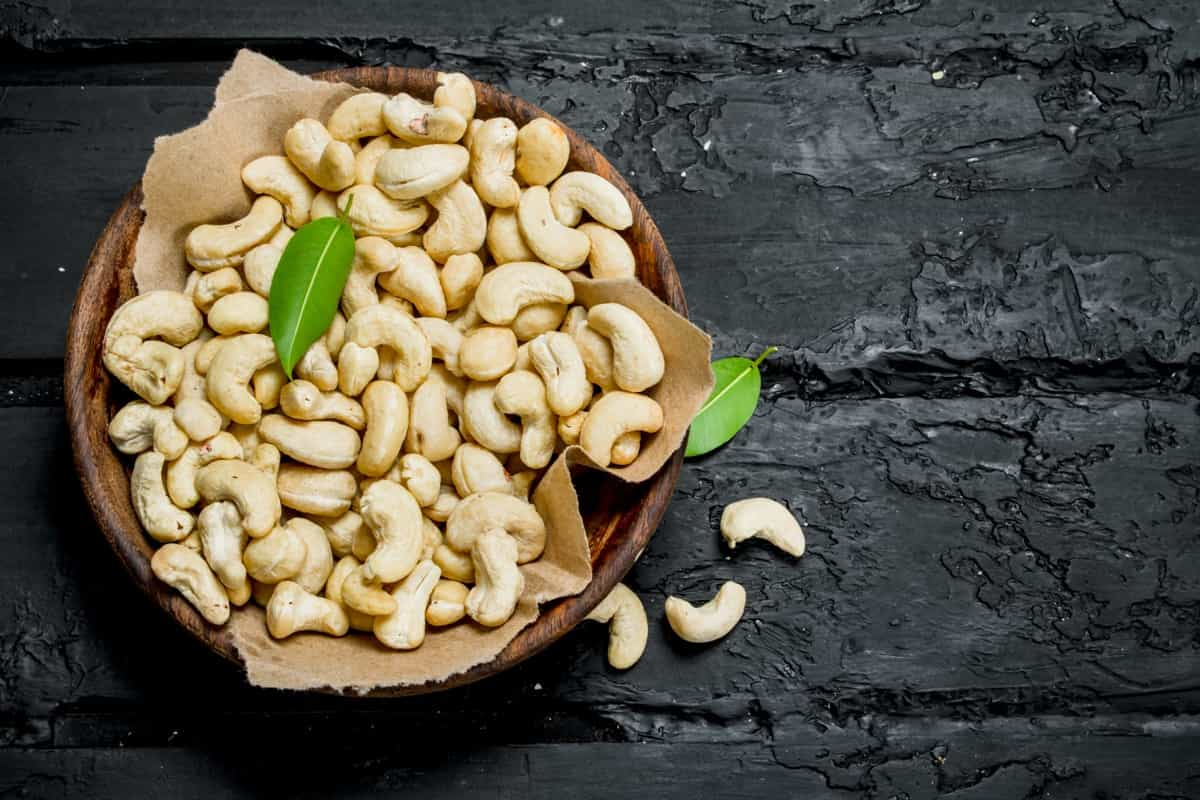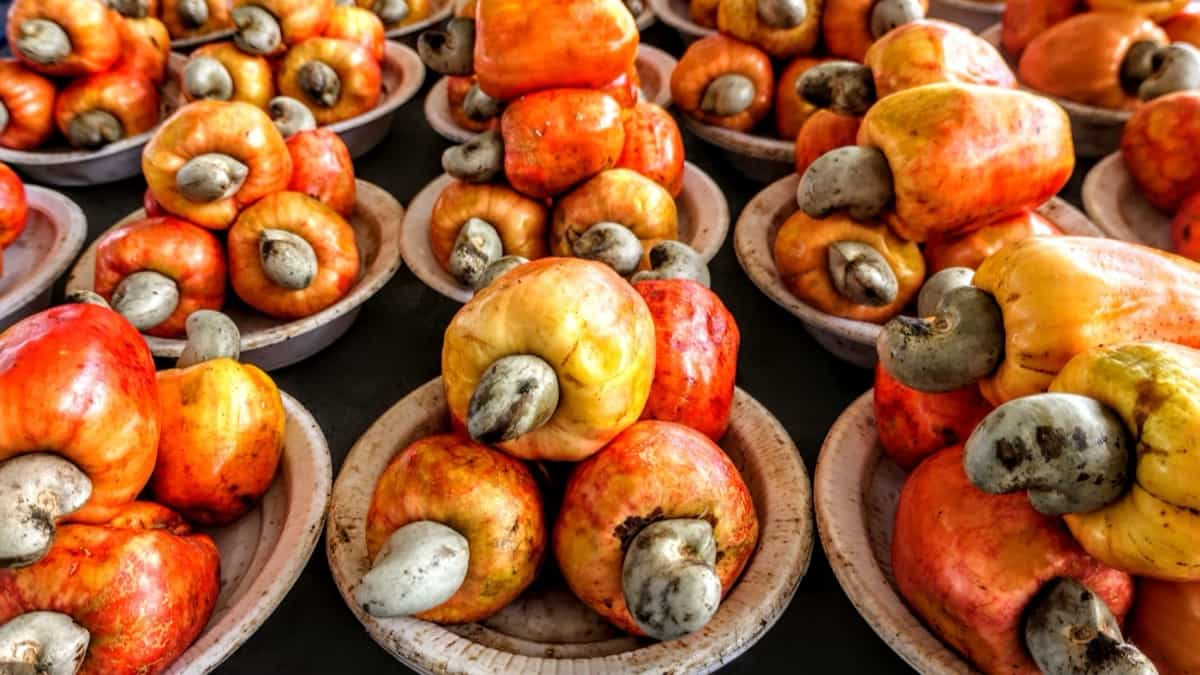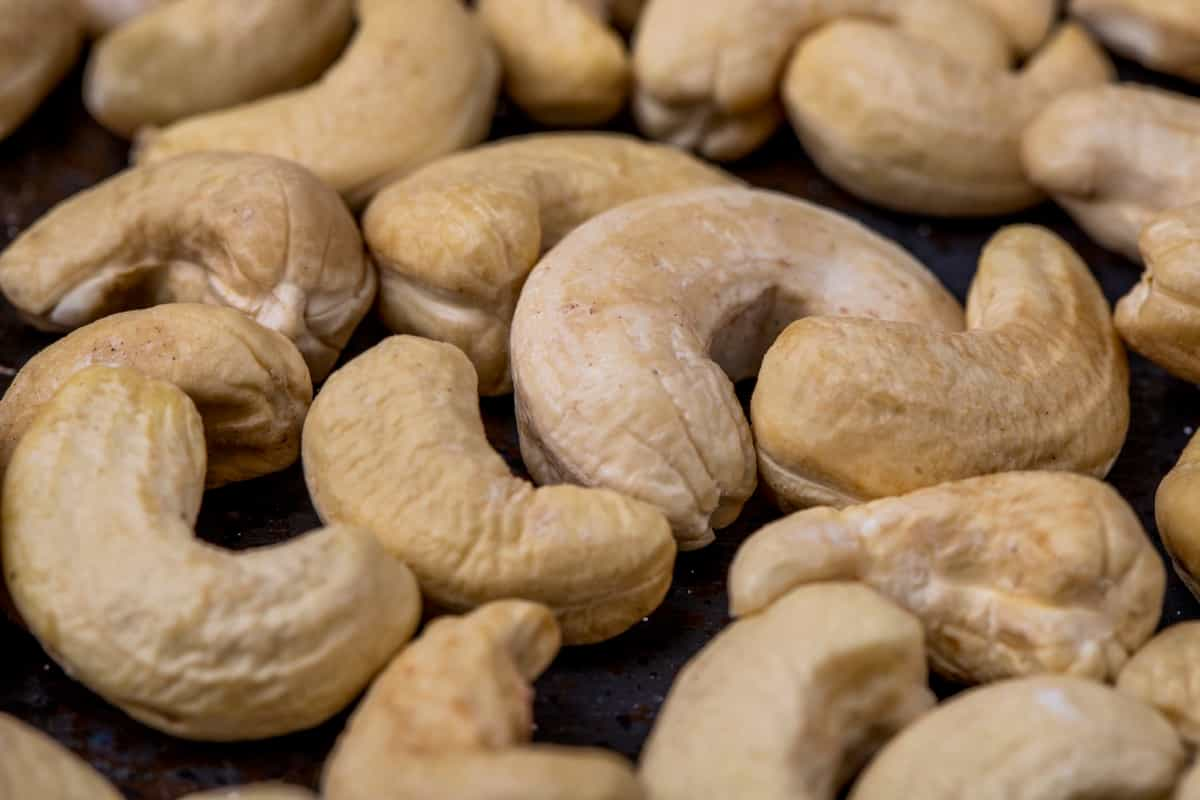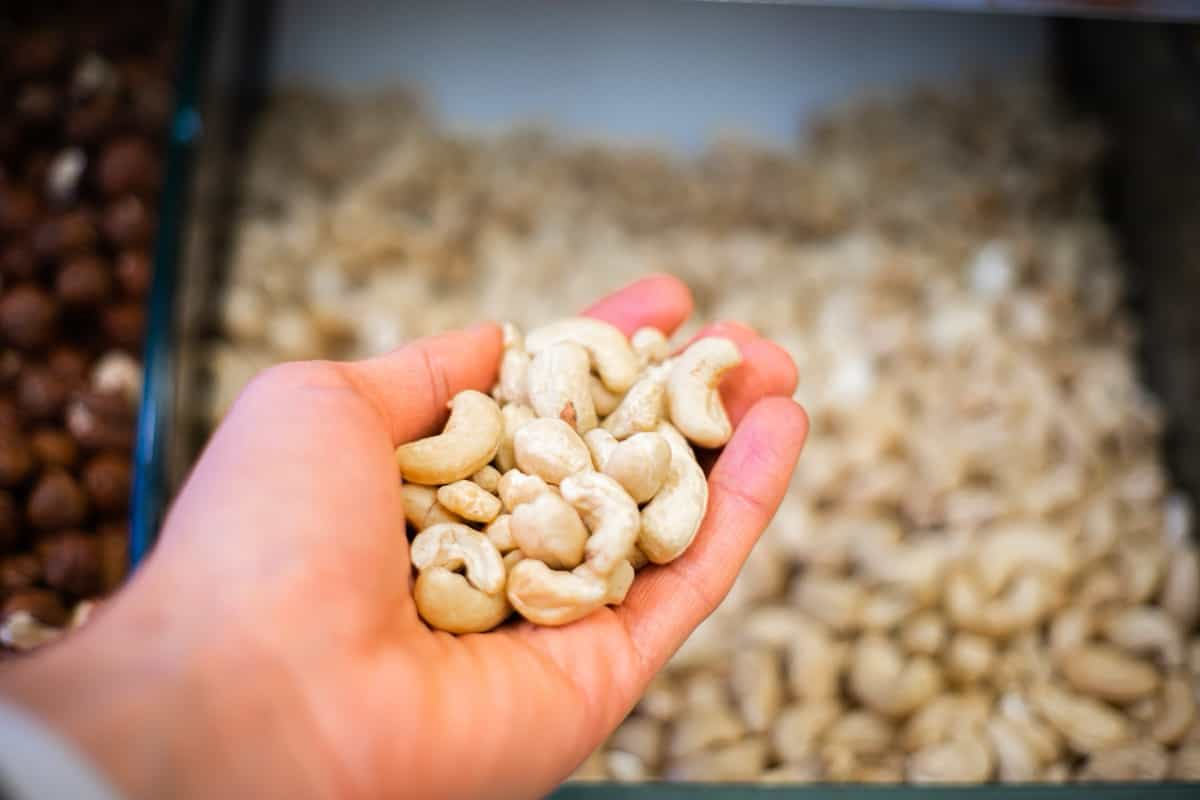The Cashew, scientifically known as Anacardium occidentale, belongs to the Anacardiaceae family. It is a tropical tree with lucrative nuts that are in high demand worldwide. Cashew farming requires attention to detail, from selecting the right location to nurturing the trees for optimal growth.

Preparing for Cashew Farming
Cashew trees thrive in tropical climates with well-drained sandy soil and plenty of sunlight. Before planting, assess your land’s suitability. Cultivating Cashews contributes to rural development by improving farmers’ livelihoods. Additionally, Cashew trees help prevent soil erosion and promote biodiversity in agroecosystems. When selecting Cashew varieties, consider factors like yield potential, disease resistance, and local market demand.
Choosing the Right Location
Cashew trees thrive in tropical climates with well-drained sandy loam soil and adequate sunlight. Selecting a location that receives plenty of sunshine is essential for optimal growth and nut production. Consider factors such as altitude, temperature, and rainfall patterns when deciding on the ideal spot for your Cashew farm.
Avoid areas prone to waterlogging or frost, as these can negatively impact tree health and yield. Additionally, ensure there is no competing vegetation or trees nearby that could overshadow your Cashew plants. Conduct thorough research or consult with agricultural experts to find a suitable location based on your specific climatic conditions and soil type.
Selecting Cashew Varieties
Popular varieties include BRS 226, Embrapa 51, and W180. Once you’ve chosen your variety, it’s time to prepare the soil. Proper soil preparation techniques can significantly impact your Cashew tree’s growth and productivity. For those looking for early-maturing options, the “BPP2” variety might be a suitable pick with its quick fruit development cycle.
On the other hand, the “Goan Red” variety stands out for its rich flavor profile, appealing to consumers seeking premium quality nuts. Consider factors like climate conditions, soil type, market demand, and personal preferences when deciding which Cashew varieties to cultivate on your farm.
Soil Preparation Techniques
The right soil preparation techniques can set the foundation for a successful Cashew farm. Based on the results, you may need to adjust the soil pH or add organic matter to improve fertility. The ideal soil pH for cashew cultivation typically ranges between 6.0 and 7.0, although cashew trees can tolerate acidic to slightly alkaline soils.
Clear the land of any debris or weeds before tilling the soil. This will ensure that your Cashew trees have ample space to grow and thrive. Consider applying compost or well-rotted manure into the soil to provide nutrients for plant growth. Ensure proper drainage by avoiding waterlogged areas and, if necessary, creating raised beds. Cashew trees prefer well-drained soils to prevent root rot and other diseases.
Planting Cashew Trees
Planting is a crucial step in starting your Cashew farming journey. To ensure successful growth, choose healthy and disease-free seedlings from reputable nurseries. When planting, make sure to dig holes deep enough to accommodate the root system of the young tree. Ensure proper spacing between each tree for optimal sunlight exposure and airflow. After placing the seedlings in the hole, gently backfill with soil while ensuring it is firmly packed around the roots.
Water newly planted Cashew trees regularly, especially during dry spells, but avoid waterlogging that can lead to root rot. Mulching around the tree base can help retain moisture and suppress weed growth. Monitor your young Cashew trees closely for any signs of stress or nutrient deficiencies. With proper care and attention during planting, you set a strong foundation for healthy Cashew tree growth and future nut production on your farm.
Nutrient Management
Cashew trees require a balanced supply of essential nutrients like nitrogen, phosphorus, potassium, magnesium, calcium, and sulfur to thrive. Regular soil testing helps determine the nutrient levels in the soil and allows farmers to adjust fertilizer applications accordingly. Organic fertilizers can be used to supplement soil nutrients naturally. Applying fertilizers at the right time during the Cashew trees’ different growth stages is important for optimal nutrient absorption.
In case you missed it: High-Density Cashew Plantation: Spacing, Plants Per Acre, Techniques, Cost, and Yield

Over-fertilization must be avoided, as it can lead to nutrient imbalances and harm the trees. Proper nutrient management not only promotes tree health but also improves yield and nut quality. As your Cashew trees grow, apply organic fertilizers rich in nitrogen, phosphorus, and potassium to boost growth and ensure nutritious nuts. Prune the Cashew tree regularly to remove dead branches and shape the tree for better yield.
Watering and Irrigation Systems
Cashews require a consistent water supply, especially during their early development stages. Proper watering helps maintain soil moisture levels, which is essential for healthy root growth. When setting up an irrigation system for your Cashew farm, consider factors like the size of your plantation, climate conditions, and water availability. Drip irrigation is often recommended as it provides targeted watering directly to the roots, maximizing water efficiency.
Monitoring soil moisture levels regularly is important to ensure that your Cashew trees receive adequate hydration. Adjusting the irrigation based on tree requirements can help prevent over- or under-watering issues. Investing in a reliable irrigation system will benefit the overall health of your Cashew trees and contribute to higher yields at harvest time.
Pruning and Training Cashew Trees
When pruning, focus on removing dead or diseased branches to promote healthy new growth. Training involves guiding the branches in the desired direction for better sunlight exposure and air circulation. Proper pruning techniques help maintain the tree’s shape and structure, preventing overcrowding that can hinder nut development. It also reduces the risk of pest infestations by improving airflow within the canopy.
Training young Cashew trees early on helps establish a strong framework for future growth. By shaping the tree during its formative years, you can encourage lateral branching and an open canopy for easier harvesting. Regularly inspect your Cashew trees for any signs of overgrowth or irregularities that may require pruning or adjustments in training methods. Remember, a well-maintained tree leads to higher yields and healthier nuts down the line.
Pest and Disease Management in Cashew Farming: Prevention and Control
Prevention and control strategies play a significant role in maintaining the overall health of Cashew trees. Pests can wreak havoc on Cashew farms, causing significant damage to the trees and affecting yield. Some common pests that Cashew farmers need to watch out for include the Cashew Nut Borer, which damages nuts by burrowing into them. The Tea Mosquito Bug is another culprit, sucking sap from young shoots and causing wilting.
The Leaf Miner is a sneaky pest that tunnels through leaves, reducing photosynthesis and weakening the tree. Farmers also face challenges from aphids and mites, which can cause discoloration of leaves and stunted growth if left unchecked. Proper monitoring and timely intervention are crucial in controlling these pests to protect Cashew crops.
The common disease in Cashew farming is Powdery Mildew, which appears as a white color powdery substance on the tree leaves and can lead to defoliation if not treated promptly. Another troublesome disease is Anthracnose, causing dark lesions on the leaves and affecting nut development. Cashew Leaf Spot is also a concern, characterized by brown spots with yellow halos on the foliage.
Fire Blight is another threat to Cashew trees, leading to wilting branches and blackened tissues. Root Rot can be devastating as well, causing root decay and stunted growth in trees. Bacterial Canker poses a risk with sunken lesions on the bark affecting overall tree health. Effective disease management strategies such as proper sanitation practices and timely application of fungicides are essential in protecting Cashew orchards from these detrimental diseases.
To prevent infestations, regular monitoring of the orchard for signs of pests is essential. Implementing cultural practices like proper spacing between trees can help reduce pest populations by improving air circulation and sunlight penetration. Additionally, using organic methods such as neem oil or botanical extracts can be effective in controlling pests without harming the environment.
In case you missed it: Top 20 Steps to Boost Cashew Yield: How to Increase Production, Cashew Size, and Quality

Weed Control Strategies
Weed control is crucial in Cashew farming to ensure the healthy growth of your trees and maximize nut production. One effective strategy is mulching around the Cashew trees with organic materials like straw or bark to retain soil moisture. Regularly inspecting your farm for weeds and manually removing them can also prevent competition for nutrients and water. Using herbicides selectively can target specific weed species while minimizing harm to the Cashew trees.
Mechanical methods such as hoeing or hand-weeding are labor-intensive but efficient ways to keep weeds at bay. Implementing proper spacing between Cashew trees can reduce shading, creating an environment less favorable for weed growth. Encouraging ground-cover plants that do not compete with Cashews for resources can provide natural weed control. Additionally, practicing good farm hygiene by disposing of weed residues properly can prevent their spread and regrowth on your land.
Flowering and Fruit Development
Once your Cashew trees reach maturity, they will start to flower and bear fruit. This is an exciting phase in the Cashew farming process as it signals upcoming harvests of delicious Cashew nuts. The flowering stage usually occurs during the dry season when conditions are optimal for pollination. Cashew flowers are unique, with vibrant colors like pink, red, and yellow, attracting bees and other pollinators to aid in fertilization.
After successful pollination, small nut-like structures called Cashew apples develop along with the iconic kidney-shaped nut attached at the bottom, known as the Cashew kernel. As these fruits mature, the apples turn from green to a bright red or yellow color while the nuts grow larger inside them. It’s crucial to monitor this stage closely to ensure proper development of both fruit components for a bountiful harvest later on.
Harvesting Cashew Nuts
Once your Cashew trees have matured and the fruits are ready for harvest, it’s time to reap the rewards of your hard work. Harvesting Cashew nuts is a delicate process that requires precision and care to ensure you obtain high-quality produce. To begin harvesting, carefully pluck the ripe Cashew apples by hand, taking care not to damage the fruit or tree branches. The nut itself is encased in a shell located at the bottom of each apple. This shell contains an acidic liquid that can cause skin irritation, so wear gloves during this step.
After collecting the Cashew apples, allow them to dry in a well-ventilated area for about 3-5 days until they turn from green to brown. Once dried, carefully remove the nuts from their shells using special equipment or tools designed for this purpose. Store your harvested Cashews in a cool and dry place to maintain their quality.
Marketing Your Cashews
Once you have harvested your nuts, it’s time to put them on the market so consumers can enjoy them. One strategy is to establish relationships with local markets, grocery stores, and specialty food shops. By offering samples of your high-quality Cashews, you can attract potential buyers. Another avenue for selling your Cashews is through online platforms. Creating an appealing brand image and showcasing the health benefits of Cashews can help increase sales.
Additionally, attending farmers’ markets or food festivals can provide opportunities to connect directly with customers and promote your product. Consider packaging your Cashews in attractive containers or bags that highlight their freshness and premium quality. Providing personalized customer service and ensuring prompt delivery will also help build trust among buyers.
Expanding Your Cashew Farm
It is an exciting opportunity to grow your business and increase your yield. One way to expand is by acquiring more land or leasing additional acreage. This will allow you to plant more Cashew trees and boost production. Another option is investing in advanced technology and equipment. Upgrading irrigation systems, implementing modern farming techniques, and using machinery can streamline operations and improve efficiency on the farm.
In case you missed it: Best Fertilizer for Cashew Tree: Organic, NPK, Compost Manure, and How to Apply

Diversifying your product range by processing Cashews into value-added products like flavored nuts or Cashew butter can also help expand your market reach. By adding value to your products, you can attract a customer and increase profitability. Exploring new markets both domestically and internationally is key to expanding your Cashew farm. Building relationships with buyers, attending trade shows, and applying online platforms can help you reach a broader audience and secure new sales opportunities.
As you expand your Cashew farm, it will be crucial to monitor market trends continuously, stay informed about industry developments, and adapt to changes. Cashew farming can be a profitable venture if approached with proper planning, knowledge, and dedication. Implementing comprehensive strategies is vital for protecting Cashew trees from common threats and ensuring long-term viability.
- Types of Pesticides Used in Agriculture: A Beginner’s Guide
- Economical Aquaculture: A Guide to Low-Budget Fish Farming
- 15 Common Planting Errors That Can Doom Your Fruit Trees
- How to Make Houseplants Bushy: Effective Tips and Ideas
- Innovative Strategies for Boosting Coconut Pollination and Yield
- Pollination Strategies for Maximum Pumpkin Yield
- The Complete Guide to Chicken Fattening: Strategies for Maximum Growth
- Natural Solutions for Tulip Problems: 100% Effective Remedies for Leaf and Bulb-Related Issues
- Revolutionizing Citrus Preservation: Towards a Healthier, Greener Future
- Natural Solutions for Peony Leaf and Flower Problems: 100% Effective Remedies
- Maximizing Profits with Avocado Contract Farming in India: A Comprehensive Guide
- Natural Solutions for Hydrangea Problems: 100% Effective Remedies for Leaf and Flowers
- The Ultimate Guide to Choosing the Perfect Foliage Friend: Bringing Life Indoors
- From Sunlight to Sustainability: 15 Ways to Use Solar Technology in Agriculture
- The Ultimate Guide to Dong Tao Chicken: Exploring from History to Raising
- The Eco-Friendly Makeover: How to Convert Your Unused Swimming Pool into a Fish Pond
- Mastering the Art of Delaware Chicken Farming: Essentials for Healthy Backyard Flocks
- 20 Best Homemade Fertilizers for Money Plant: DIY Recipes and Application Methods
- How to Craft a Comprehensive Free-Range Chicken Farming Business Plan
- Brighten Your Flock: Raising Easter Egger Chickens for Beauty and Bounty
- How to Optimize Your Poultry Egg Farm Business Plan with These Strategies
- Subsidy for Spirulina Cultivation: How Indian Government Schemes Encouraging Spirulina Farmers
- Ultimate Guide to Raising Dominique Chickens: Breeding, Feeding, Egg-Production, and Care
- Mastering the Art of Raising Jersey Giant Chickens: Care, Feeding, and More
- Ultimate Guide to Raising Legbar Chickens: Breeding, Farming Practices, Diet, Egg-Production
- How to Raise Welsummer Chickens: A Comprehensive Guide for Beginners
- How to Protect Indoor Plants in Winter: A Comprehensive Guide
- Ultimate Guide to Grow Bag Gardening: Tips, Tricks, and Planting Ideas for Urban Gardeners
- Guide to Lotus Cultivation: How to Propagate, Plant, Grow, Care, Cost, and Profit
- Agriculture Drone Subsidy Scheme: Government Kisan Subsidy, License, and How to Apply Online
- Ultimate Guide to Raising Araucana Chickens: Breed Profile, Farming Economics, Diet, and Care
- Bringing Hydroponics to Classroom: Importance, Benefits of Learning for School Students
- Ultimate Guide to Raising Polish Chickens: Breed Profile, Farming Economics, Diet, and Care
- Ultimate Guide to Raising Australorp Chickens: Profile, Farming Economics, Egg Production, Diet, and Care
- Silkie Chicken Farming: Raising Practices, Varieties, Egg Production, Diet, and Care
- Sussex Chicken Farming: Raising Practices, Varieties, Egg Production, Diet and Care
Thank you for your more valuable information. Sir there is a 5 acre cashew nut farming in my own land. Last year we collected approximate 10 quintal raw cashew nuts. But some trees which provide more cashew nuts suffered by some disease which is not known by me.The disease is like there are some blackish brown pests are over the main stem and after one year the tree was completely dead.
Please give some advice regarding the treatment of above.
Well, there may be many reasons why the healthy cashew nut trees are dead. One has to analyse the symptoms of the tree before suggesting any fertigation. You better contact your local horticulture department for symptoms and disease control methods.
We don’t have phone support. you can post your comments or questions here at Agri Farming.
Its good to read your writings. I will be very pleased if you sincerely let me know how to grow them as I have collected 3 seeds with all difficulty faced! The month and everything involved…. Thanks
Did you read about how to grow seedlings from seeds?
I am Emmanuel From Uganda looking for seeds for cashew nuts.
We don’t sell any vegetable seeds, fruit seeds or any agriculture produce.
Can I grow/propagate cashew nut plant from it’s cuttings with or without using any rooting hormone? Also, can the Aloe Vera gel extracted from it’s leaf be used as a natural rooting hormone?
In my cashew farms flowers blooms In the East side of the trees. In other sides of the trees no result.
What’s the problems?
Greetings,
My name is Aliasgar and I come from Tanzania. The purpose of this message is that I need some professional advice on the processing of cashew nuts. What are your opinions and advices about this situation and please provide me with information on which machinery to buy. I will be waiting for your prompt reply.
Thank you.
Well, You can read about: Cashew Nut Farming Project Report.
Sir, I Want To Know Uttar Pradesh (Sultanpur Distt) Is Suitable For Cashew Farming?
Check this project report for suitable soil and climate: Cashew Nut Farming Project.
Sir Where can we get cashew nut seeds for planting?
Good day, I’m from South Africa.
I’m looking for cashew nut seeds that I can buy to grow. I’ve bought on ebay, but those are definitely not cashew nut seeds.
Can you please assist me in this matter? I can’t seem to find them anywhere. I own a small business where I’m growing and selling all kinds of trees and plants and I would like to buy 300 seeds.
Thank you.
Laurika Veldhoën
Quite informative
Hi ,
Can we get a tour of whole process in person?